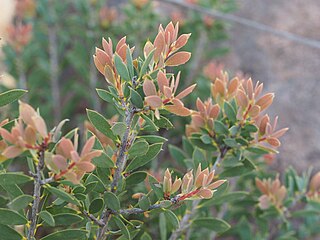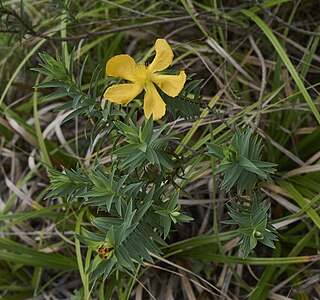Related Research Articles

The Swamp Thing is a fictional superhero in American comic books published by DC Comics. A humanoid/plant elemental creature, created by writer Len Wein and artist Bernie Wrightson, the Swamp Thing has had several humanoid or monster incarnations in various different storylines. The character first appeared in House of Secrets #92 in a stand-alone horror story set in the early 20th century. The character then returned in a solo series, set in the contemporary world and in the general DC continuity. The character is a swamp monster that resembles an anthropomorphic mound of vegetable matter, and fights to protect his swamp home, the environment in general, and humanity from various supernatural or terrorist threats.

Poison Ivy is a fictional supervillain appearing in comic books published by DC Comics, commonly in Batman stories. Poison Ivy was created by Robert Kanigher and Sheldon Moldoff, and made her debut in Batman #181.

Smilax is a genus of about 300–350 species, found in the tropics and subtropics worldwide. In China for example about 80 are found, while there are 20 in North America north of Mexico. They are climbing flowering plants, many of which are woody and/or thorny, in the monocotyledon family Smilacaceae, native throughout the tropical and subtropical regions of the world. Common names include catbriers, greenbriers, prickly-ivys and smilaxes. Sarsaparilla is a name used specifically for the Jamaican S. ornata as well as a catch-all term in particular for American species. Occasionally, the non-woody species such as the smooth herbaceous greenbrier are separated as genus Nemexia; they are commonly known by the rather ambiguous name carrion flowers.

Hibiscus is a genus of flowering plants in the mallow family, Malvaceae. The genus is quite large, comprising several hundred species that are native to warm temperate, subtropical and tropical regions throughout the world. Member species are renowned for their large, showy flowers and those species are commonly known simply as "hibiscus", or less widely known as rose mallow. Other names include hardy hibiscus, rose of sharon, and tropical hibiscus.

The Primulaceae, commonly known as the primrose family, are a family of herbaceous and woody flowering plants including some favorite garden plants and wildflowers. Most are perennial though some species, such as scarlet pimpernel, are annuals. It includes the former families Myrsinaceae, Theophrastaceae and Maesaceae.

The Floronic Man, also known as the Plant Master, Floro, and the Seeder, is a fictional supervillain appearing in American comic books published by DC Comics.

Desmodium is a genus in the flowering plant family Fabaceae, sometimes called tick-trefoil, tick clover, hitch hikers or beggar lice. There are dozens of species and the delimitation of the genus has shifted much over time.

Astereae is a tribe of plants in the family Asteraceae that includes annuals, biennials, perennials, subshrubs, shrubs, and trees. Plants within the tribe are present nearly worldwide divided into 170 genera and more than 2,800 species, making it the second-largest tribe in the family behind Senecioneae. They are found primarily in temperate regions of the world.

Melaleuca styphelioides, known as the prickly-leaved paperbark or prickly paperbark, is a plant native to eastern Australia. It is a tree with spongy bark, prickly leaves and spikes of creamy-white flowers.
The nominal power is the nameplate capacity of photovoltaic (PV) devices, such as solar cells, modules and systems, and is determined by measuring the electric current and voltage in a circuit, while varying the resistance under precisely defined conditions. The nominal power is important for designing an installation in order to correctly dimension its cabling and converters.
Macowania is a genus of African flowering plants in the pussy's-toes tribe within the sunflower family.

Ranunculus lappaceus, commonly known as the common buttercup, Australian buttercup or Yarrakalgamba, is found across eastern Australia. Like buttercups elsewhere, it is a perennial herb with yellow flowers appearing in spring and summer.

Amyema congener, commonly known as the variable mistletoe, is a species of flowering plant, an epiphytic hemiparasitic plant of the family Loranthaceae from eastern Australia. It is found on members of the genera Allocasuarina, Acacia and some exotic species.

Melaleuca deanei, commonly known as Deane's paperbark, is a plant in the myrtle family, Myrtaceae and is endemic to New South Wales in Australia. It is a shrub with flaky bark, narrow oval leaves and spikes of white flowers in spring and summer. The species only exists in a few isolated populations and is classified as vulnerable.

Hypericum terrae-firmae is a woody perennial flowering plant in the St. John's wort family Hypericaceae. It is an endemic plant species of Belize.

Tellimagrandin I is an ellagitannin found in plants, such as Cornus canadensis, Eucalyptus globulus, Melaleuca styphelioides, Rosa rugosa, and walnut. It is composed of two galloyl and one hexahydroxydiphenyl groups bound to a glucose residue. It differs from Tellimagrandin II only by a hydroxyl group instead of a third galloyl group. It is also structurally similar to punigluconin and pedunculagin, two more ellagitannin monomers.

Muellerina eucalyptoides, or creeping mistletoe, is a hemiparasitic arial shrub in the family Loranthaceae. The species is endemic to Australia. M. eucalyptoides is pendulous in habit, unlike other Muellerina species, but has the long epicortical runners of all Muellerina species.
Hypericum styphelioides is a perennial flowering plant in the St. John's wort family Hypericaceae. It is endemic to Cuba.